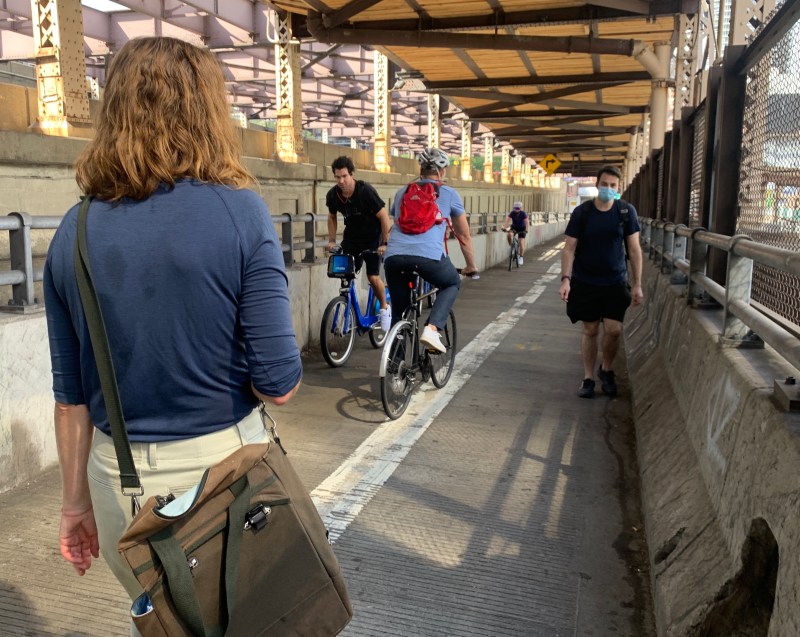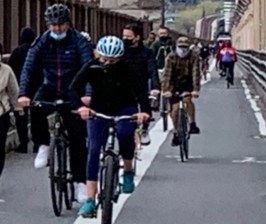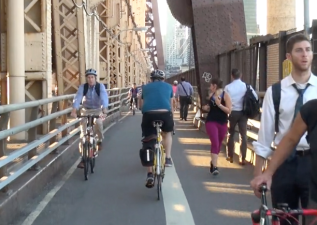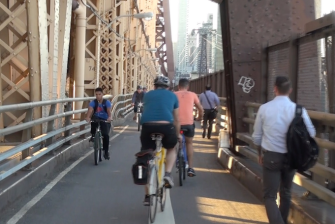OPINION: No More Excuses on Queensboro Bridge South Outer Roadway


Enough with the excuses.
Months after 200 of us marched and demanded a dedicated sidewalk for pedestrians on the Queensboro Bridge, the city Department of Transportation keeps giving us the silent treatment. Never mind a mind-boggling 40-percent increase in bike traffic on the bridge this year, never mind looming climate change, never mind the inevitability of congestion pricing, which will reduce car traffic. No, the city is still leaning on its most risible pretext — safety — for delaying the conversion of the “south outer roadway” of the span from a lightly used vehicle lane to a pedestrian sidewalk.
But remember, the south outer roadway used to be a pedestrian and bicycle path. It’s a safe, comfortable place to walk. The current arrangement of lanes on the bridge forces pedestrians to share a narrow, steep, filthy path with cyclists, while drivers get the other nine lanes on the span. Meanwhile, the south roadway is wide, has a shallow grade, and connects with Manhattan in the dignified beauty of Honey Locust Park.

But the city is refusing to do it. DOT says opening the path would be unsafe — and it’s too costly to put up the higher safety railing that the agency claims it needs.
Needs? Compared to what? Does the agency need the sidewalk to be as safe as their own carpeted offices? In engineering, you don’t compare a proposal with the Platonic ideal, you compare it with existing conditions. And the existing conditions are a disaster. Not a disaster waiting to happen, but a disaster that is happening.
Unfortunately — and maybe intentionally — the city doesn’t track injuries on the bridge in its “Vision Zero” data. So for two years, Transportation Alternatives Western Queens Volunteer Committee has maintained a “crash reporter” web page where people tell us about incidents on the narrow, shared pedestrian-bicycle path. DOT has never asked about the kinds of crashes we’re seeing. If it had, it would be ashamed to use “safety” as an argument.
Here is a selection, edited for clarity. Again, this is just a selection. There are more:
- Skateboarders going in opposite directions collided when the one going east had to swerve to avoid a pedestrian, and the westbound one wasn’t able to stop. The pedestrian injured his ankle. One boarder got a bloody knee.
- A pedestrian stepped backward into the bike lane to take a photo of her friends in the walking lane, right in front of a cyclist. The cyclist hit the photographer and slammed into the wall. Both were bruised.
- A cyclist swerved to avoid a pedestrian’s unexpected movement, and then swerved again to avoid an oncoming biker. The quick movements caused the cyclist to crash, breaking an elbow and clavicle, and receiving a concussion.
- A cyclist in the pedestrian lane cut back into bike lane, right into the path of another rider. The surprised rider stopped short and flipped over, breaking his jaw. It was wired shut for nearly seven weeks. He lost three teeth.
- A cyclist heading into Manhattan clipped a pedestrian and lost control of his bike. He slammed into the wall and broke his glasses.
- One cyclist tried to pass another and collided with a third, oncoming cyclist. All three went down.
-
The Queensboro Bridge, packed with essential workers just trying to get to and from work. File photo: Melodie Bryant A cyclist descending into Queens was hugging the right rail at 22 mph. An uphill cyclist with his head down popped out to pass someone. They crashed head-on. The downhill rider went over his handlebars and ended up under his bike.
- At the Queens end, an eastbound cyclist crashed by either hitting or avoiding a Manhattan-bound cyclist.
- A cyclist on his first ride over the bridge crashed head-on with a scooter at the apex of the bridge. He was scratched and bleeding. His bike had damaged brakes and a broken spoke. Another cyclist smashed into his fallen bike.
- A rider’s right arm was injured when a cyclist coming the other way smashed into his handlebars.
- A cyclist riding downhill into Queens was passing a group of uphill riders on Citi Bikes, one of whom swerved right into the path of the downhill rider. The downhill rider’s finger was crushed between his handlebars and that of the Citi Bike. He needed surgery.
- A cyclist riding with his dog over the bridge was hit by a scooter, and the dog was killed.
We get scores of such reports. One recent contributor to the page added a poignant comment after witnessing a bloodied man who was on the pavement, unmoving: “I don’t want to end up like this poor guy.”
Faced with this litany of agony, our DOT says a separate south sidewalk won’t be safe enough without a new security fence. Again, safe compared to what?
DOT won’t say what exactly it’s so worried about, given that the existing fence on the south outer roadway is much higher than the one on the Triborough Bridge and it’s higher than the one that DOT built on the recently reconstructed Pulaski bridge sidewalk. The agency may say it is concerned about suicides or vandals dropping objects on the FDR Drive or even shoe bombers. But these are literally imaginary issues that exist solely in the realm of speculation. Meanwhile, real blood is being spilled here in the real world.
Turning the south lane over to pedestrians will increase safety.
Steven Bodzin is a volunteer with Transportation Alternatives Western Queens Committee, where he has been helping press for a dedicated pedestrian sidewalk on the bridge for three years. He has previously helped win bike and pedestrian access to the San Francisco-Oakland Bay Bridge and Richmond-San Rafael Bridge in California. Follow him on Twitter @stevenbodzin.



